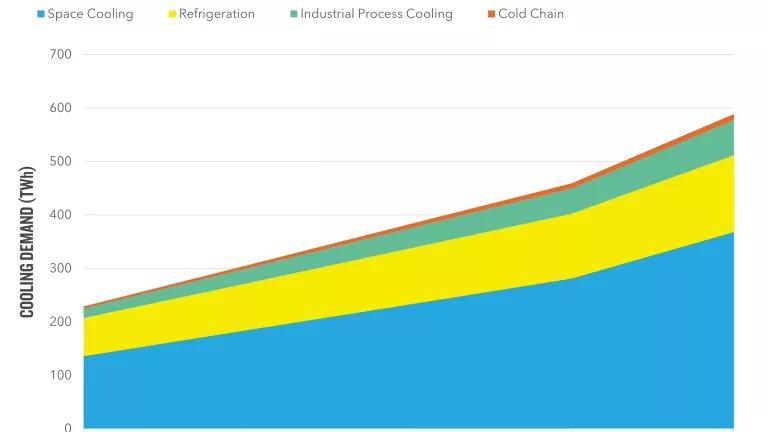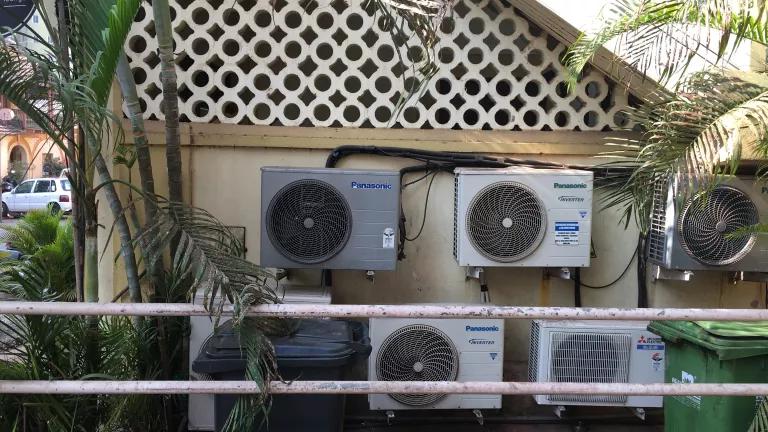
A shoemaker using a shed as protection from heat at Iskon Bridge in India.
Co-authored with Tanvi Dutta Gupta and Nishara Fernando
Experts outline priorities for ensuring climate friendly cooling in India
Despite weeks of rain, temperatures across India remain at record-breaking highs. As climate change promises longer, hotter, and more frequent heatwaves, waiting for cooler temperatures is no longer a viable option for most Indians: now, the question is how to live through the heat as it threatens to exceed survivable limits. Lower income populations are at the highest risk due to lack of access to cooling solutions. India has one of the fastest growing needs for cooling. However, this need will require to be met through sustainable sources or it could be lethal for the climate. To support a more climate-friendly cooling transition in India, NRDC and The Energy and Resources Institute (TERI) hosted a workshop last week in Delhi, where stakeholders gathered to discuss the solutions and challenges of increasing cooling access without exacerbating climate impacts.
Rising Cooling Equipment Ownership
Projections indicate that refrigerator and air-conditioner (AC) ownership numbers in India are set to explode. As temperatures rise with per-capita incomes, and as people search for ways to adapt to heat stress, India is expected account for more than a third ofthe world’s air-conditioner sales in the decades to come. Unfortunately, AC equipment relies on chemicals, such as hydrofluorocarbons (HFCs), to produce the cooling effect. HFCs have high global warming potential (GWP)—hundreds to thousands of times that of CO2 on a kilogram-for-kilogram basis. The Montreal Protocol on Substances that Deplete the Ozone Layer responded to this crisis through the 2016 Kigali Amendment, a landmark global multilateral agreement that aims to bring about the phase-down of HFCs. After playing a critical role in bringing about the success of the initial Montreal Protocol, India ratified its Kigali Amendment in September 2021. The implementation of the Kigali Amendment in India is both a challenge and opportunity, as the country needs to think of ways to meet its growing cooling needs while transitioning away from high GWP HFC use.
Stakeholders Gather Around a Hot Topic and Highlight Joint Action on Cooling
Last week, the NRDC and TERI-hosted event, “Maximizing the Benefits of Climate-friendly Cooling Through Successful Implementation of the Kigali Amendment,” brought together stakeholders—including industry, government, civil society, and more—to discuss how to cool the country at low cost to the climate.

Experts at the TERI-NRDC workshop on climate friendly cooling in New Delhi, India
Both the government and industry emphasized the importance of collaborative action to build on India’s climate efforts so far and pointed out that the India Cooling Action Plan (ICAP) demonstrates the commitment to multipronged, cross-sectoral action. “This action will have benefits not just for complying with the Kigali Amendment, but also in improving living conditions and food security for people around the country,” said Sanjay Seth, TERI.
Aditya Narayan Singh, Ozone Cell, highlighted, “India has taken a proactive role in climate action on cooling through its ICAP, which provides the framework for acting in different sectors. A key theme of the ICAP is to take synergistic actions, which are stronger than actions taken in isolation.” Highlighting industry’s commitment to climate friendly cooling, Kanwal Jeet Jawa from Daikin India said, “India will become the largest air conditioning market in the world by the middle of this century. Living conditions and food security for our people cannot be ignored. We need a multipronged approach to realize the Kigali Amendment targets, and on-ground technical actions like product innovations must be accelerated.”
Though most refrigerants in India are based on chemicals to be phased down under the Kigali Amendment, industry leaders repeatedly said they expect to meet and even exceed the Amendment’s expectations. “The industry track record shows that we can complete the transition away from high global warming potential refrigerants much faster than expected,” said Dr. Rajani Ranjan Rashmi, TERI. Kapil Singhal from BP Refcool pointed out the baseline for India’s transition away from HFCs will come much faster than expected. “We are not playing test cricket, we are playing T20,” he said. “And we need to hit every ball.” Sameer Kwatra, NRDC India, noted India’s transition timeline can bring it out of sync with international colleagues. The current timeline, which anticipates a phase-down in 2028, means India starts batting when everyone else has achieved 70% of their target. “We play in a global market, and we cannot be that far behind the rest,” Kwatra said.

Experts at TER-NRDC Cooling Workshop Discussing Kigali Amendment Implementation in India
Speakers also discussed the holistic preparation this change requires—not only designing buildings and infrastructure to minimize their energy requirements, but also ensuring sufficient retrofitting programs are available, building important safety considerations into the process, and, most importantly, preparing users. Gaurav Mehtani from Refrigerant and Air-Conditioners Manufacturers Association (RAMA) emphasized once more that while industry is ready, “some of the users are not ready to invest in new technologies.” Srinivasu Moturi, representing the Consumer Electronics and Appliances Manufacturers Association (CEAMA), pointed out the current attention may not be focused on the largest areas of growth in refrigeration; commercial refrigeration, for example, experienced a more than 100% growth in the last year, yet remains, as Moturi described it, “one of the most neglected areas of refrigeration.”
Government policy can play a role in encouraging change. Pradeep Mukerjee, CLASP, emphasized the role that government standards play in shaping products and demand. “The phase-down can happen much earlier if we start preparing the standards as fast as possible,” he said, describing how the Bureau of Energy Efficiency’s labeling program had enabled the growth and penetration of high energy efficiency equipment. The policy frameworks already exist in India: we just need to build on it.
New Research Shows a Cool Way Forward
The event also marked the release of a new NRDC and TERI publication on cooling. A new journal article from NRDC-TERI experts and other colleagues, “Scenarios for future Indian HFC demand compared to the Kigali amendment”, published in Environmental Research Letters, examined how different scenarios of compliance with the Kigali Amendment would affect HFC demand in India. The study shows that India’s present day cooling trends—of low access and penetration, especially for air conditioning and refrigeration— will likely be short lived. To comply with the Kigali Amendment, annual Indian HFC demand in India must peak at approximately projected 57 MMT CO2e in 2030 and fall to 8 MMT CO2e by 2050. With an accelerated transition away from HFCs, demand will peak in 2028. India would then exceed its obligations under the Kigali Amendment. Read the study summary here and full study is available here.


India’s cooling industry is at a crossroads of a transformation. It has already shown proactive action; with greater stakeholder collaboration and with a few smart and timely actions, India’s industries can set the stage for successful long term climate friendly cooling gains—a boon for the people of India, for the world and for the environment.
Tanvi Dutta Gupta is Schneider Summer Fellow and Nishara Fernando is a Cameroon and Speth Fellow, working with the NRDC India Program.




